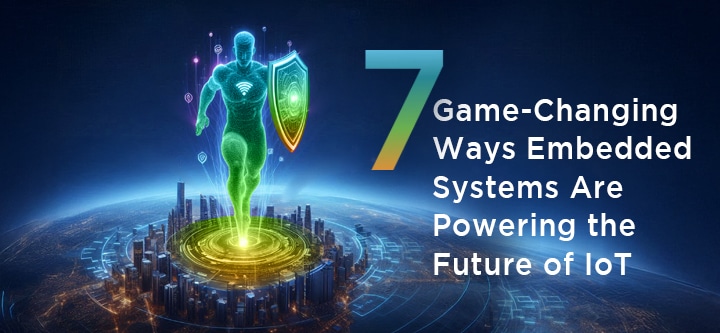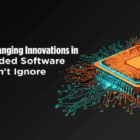The Internet of Things (IoT) is expanding faster than ever, with applications in industries from healthcare to agriculture and smart cities. At the heart of IoT’s rise are embedded systems—specialized computing units designed to perform dedicated tasks, often with real-time constraints. In 2025, the global embedded systems market is estimated to exceed $120 billion, driven by the rapid adoption of IoT devices and increasing technological advancements in embedded systems. By seamlessly integrating these systems, IoT devices are transforming everyday experiences, bringing a new era of intelligence, efficiency, and connectivity.
Let’s explore seven powerful ways embedded systems are revolutionizing IoT in 2025.
1. Real-Time Responsiveness: “Quick Actions, Faster Reactions”
Embedded systems are optimized for real-time responsiveness, making them ideal for IoT applications where split-second actions are crucial. Real-time operating systems (RTOS) allow IoT devices to respond to inputs and outputs immediately, which is essential in sectors like healthcare for monitoring critical patient vitals, in autonomous vehicles for rapid decision-making, and in industrial automation for minimizing downtime.
A recent 2024 survey by Embedded World showed that over 70% of IoT developers are now prioritizing real-time capabilities in embedded systems to meet the demands of fast-paced applications. This shift highlights the importance of real-time responsiveness in enabling IoT systems to function reliably and reactively.
2. Enhanced Connectivity: “Linking the World, Device by Device”
The integration of embedded systems in IoT has redefined connectivity. Using low-power wireless communication protocols like Bluetooth Low Energy (BLE), Zigbee, and LPWAN, embedded systems in IoT devices can now connect seamlessly across vast networks. This connectivity is essential for smart cities, where IoT devices like traffic sensors and street lighting systems rely on continuous data exchange to function efficiently.
In 2024, reports indicate a surge in IoT installations within urban areas, with estimates predicting an 18% year-on-year growth in smart city IoT deployments. Embedded systems play a crucial role in this growth, providing efficient, reliable communication between devices and enabling data-driven urban management.
3. Energy Efficiency: “Battery Life Boosts, Power that Lasts”
For IoT devices deployed in remote or hard-to-access areas, energy efficiency is key. Embedded systems contribute significantly to power management by minimizing energy consumption, which extends the lifespan of battery-powered devices. Technologies like sleep mode and low-power processing in embedded systems allow IoT devices to function effectively for extended periods, even with limited power sources.
According to Statista’s 2024 research, energy-efficient embedded systems are expected to reduce battery consumption in IoT devices by up to 35% in the next two years, underscoring the value of energy-saving embedded solutions in the IoT ecosystem. Evolute’s commitment to power-efficient technologies aligns well with this trend, ensuring sustainable and long-lasting IoT devices across various applications.
4. Security by Design: “Built-In Defense, Protecting Your Space”
With the proliferation of IoT devices comes increased vulnerability to cyberattacks. Embedded systems contribute to robust security measures by integrating secure boot processes, encryption protocols, and multi-factor authentication directly into IoT devices. This approach ensures that IoT devices are protected from unauthorized access and data breaches from the moment they are powered on.
A 2024 report by Cybersecurity Ventures predicts that IoT-related cyberattacks will cost the global economy $8 trillion by 2025, emphasizing the need for secure embedded systems. By building security into the design, embedded systems protect IoT devices and the sensitive data they handle, fostering user confidence in smart devices.
5. Scalability: “Growing Pains, Solved with Gains”
Embedded systems enable IoT devices to scale effectively as new functionalities are required. With modular designs and flexible operating systems, embedded systems can support additional sensors, expand storage, and incorporate software updates without needing a complete hardware overhaul. This scalability is especially relevant in sectors like manufacturing, where IoT devices may need to evolve to meet changing production requirements.
In 2024, scalability has become a top priority, with industry analysts at McKinsey highlighting that 50% of IoT-enabled companies are looking to scale their devices within the next year. Embedded systems make it possible to add functionalities without a complete redesign, saving both time and resources.
6. Intelligent Edge Computing: “Decentralized Data, Smarter Solutions”
Edge computing, which processes data close to where it is generated, is enhanced by embedded systems that can analyze and process data locally. This approach reduces latency, conserves bandwidth, and allows devices to operate even in areas with limited connectivity. For instance, embedded systems in IoT devices used in agriculture can process environmental data on-site, enabling real-time decisions without relying on remote cloud servers.
A 2024 Forbes report notes that 43% of companies now prioritize edge computing for IoT devices due to its speed and efficiency. Evolute’s emphasis on integrating embedded systems with edge capabilities supports the shift toward smarter, decentralized data solutions that empower industries like agriculture and healthcare.
7. Cost-Effectiveness: “Value for Money, Built to Last”
As IoT adoption increases, cost-effectiveness is becoming a critical factor. Embedded systems are designed for specific tasks, minimizing hardware requirements and making IoT deployments affordable. Instead of investing in complex computing units, IoT devices can use lightweight, task-oriented embedded systems, reducing overall production and maintenance costs.
The 2024 Embedded Market Study indicates that companies are now saving an average of 30% on costs by using embedded systems in IoT devices, proving that purpose-built solutions are more economical than general-purpose computing. With Evolute’s approach to embedded solutions, clients benefit from cost-effective devices that deliver high performance at a fraction of the cost.
The Evolute Advantage in Embedded IoT
At Evolute, we believe in advancing the integration of embedded systems in IoT through innovation and strategic design. Our embedded solutions are purpose-built to address the unique challenges of IoT environments, from low-power consumption and real-time processing to secure and scalable designs. By supporting businesses across industries, Evolute is pioneering a new era in IoT with embedded systems that are not only reliable and efficient but also future-ready.
A New Era for IoT with Embedded Systems
The synergy between embedded systems and IoT is creating smarter, more efficient devices that redefine what’s possible in industries around the world. Here’s a quick recap of the seven revolutionary ways embedded systems are transforming IoT:
- Real-time responsiveness ensures IoT devices respond instantly to critical inputs.
- Enhanced connectivity creates seamless data flow across IoT networks.
- Energy efficiency maximizes device lifespan and sustainability.
- Security by Design provides built-in defenses for user data.
- Scalability enables IoT devices to grow and adapt with ease.
- Intelligent Edge Computing empowers smarter, local data processing.
- Cost-effectiveness makes IoT affordable and accessible.
By leveraging embedded systems, IoT is evolving to bring us closer to a truly connected, intelligent world. The future of IoT is here, and it’s powered by the incredible advancements in embedded technology.





